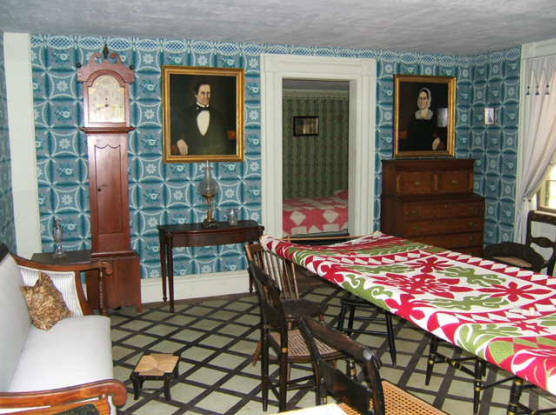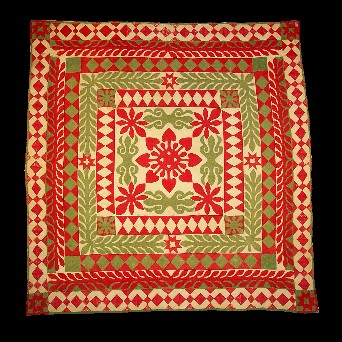|
If you think that a two hundred acre village,
created from a collection of rural 19th century buildings, is a near-perfect
site for an exhibit of antique quilts, I would strongly agree with you! A
leisurely drive on a beautiful spring day took me to the Genesee Country
Village & Museum in Mumford, New York, which lies 22 miles southwest of
Rochester, for this event. The perfect stone houses, beautifully manicured
farms, and stone fences in the surrounding countryside were the harbinger of a
not-to-be-forgotten historic journey.

The quilt exhibit, Quilts Uncovered, opened in June of 2004. It was my good
fortune that it was held over to the 2005 season, and will remain on display
through October. This collection was gathered during the decade prior to the
museum opening in 1976. It was the goal of then curator, Doris E. Hoot, to
collect quilts to furnish the historic houses and to provide examples of 19th
century textiles for the public's viewing. Ms. Hoot built a collection that
exemplifies nearly every style of 19th century quiltmaking, beginning with
early wholecloth quilts through the late 1800's crazy quilts. As it became
clear that conditions present in the old buildings were not conducive to the
long-term survival of the quilts, the museum's quilters began the task of
reproducing the original quilts for displaying in the buildings. They have been
doing so for more than twenty-five years.

I timed my visit to coincide with the museum's special event called "In
Praise of Quilts" which was held on May 21st-22nd, 2005. "In Praise
of Quilts" was "a weekend all about quilts," accomplished in
partnership with the Genesee Valley Quilt Club, a local quilt guild whose
members have given hundreds of hours of their time to produce this wonderful
festival. Pat Pauley, also a GVQC member, was the guest curator who designed
this exhibit. In the words of Connie Cox Bodner, Ph.D., Senior Director of
Programs and Collections for the museum, "Pat is an extraordinarily
talented person and the beauty and quality that are found in this exhibit are
the result of her work."

I arrived at the front entrance and was told there were two main areas for the
weekend's festivities. The quilts were hung in the John L. Wehle Art Gallery, a
short walk into the village from the main entrance. The vendors were located in
the lobby to the gallery. The lectures, appraisals, and demonstrations were
held in the Education Facility, adjacent to the entrance.

I headed straight for the gallery, knowing I would return to the education area
later for the afternoon lecture. The building was marked in great style by a
large canvas banner printed with the image of a striking and unusual red and
green medallion appliqué quilt (c.1860) which was the "logo quilt"
for the exhibit. Making a beeline for the quilts, I passed the busy vendor
booths (unusual for me) and the smiling, helpful museum employees and came face
to face with this medallion quilt in all its glory-on the wall outside the
entrance to the gallery. A spotlight shone down on it. It evoked thoughts of so
many influences at once-Pennsylvania Dutch elements, scherenschnitte (German
paper cutting technique), the Hawaiian style, and I wondered, "Who made
this wonderful quilt?" Unfortunately, she remains unknown. Next, I
observed the series of pieced and appliquéd borders and gasped when I realized
all of the appliqué was perfectly applied by machine.
 Some weeks before my trip, I came across two
antique quilts (in two separate books), one a full-size quilt and the other a
crib quilt; they had a similar structure of star blocks on point and the
identical chintz fabric in the borders. Some weeks before my trip, I came across two
antique quilts (in two separate books), one a full-size quilt and the other a
crib quilt; they had a similar structure of star blocks on point and the
identical chintz fabric in the borders.
I began to wonder if they came from the same
household and had even asked a noted quilt expert if she were aware of
documentation of other full-size and crib quilts from the same household. She
gave suggestions on where to look for possible answers to my question, which,
of course, I had not yet completed. With that bit of introduction, you might
understand the smile on my face when I discovered that the wonderful
"logo" quilt had a companion crib quilt hanging in the gallery,
almost certainly by the hand of the same person.

The first room in the gallery held a textbook
collection of early quilts: Wholecloth, Broderie Perse Medallion, Whitework and
Strippy quilts. I have a real fondness for these early quilts, most of which
were labeled c. 1825. The chintzes were both woodblock and copperplate, and
many of the quilts were bound with twill tape. Perfectly positioned in the
corner of the room was a four-poster bed, displaying a reproduction of the
Friendship Star quilt in the collection, which was made by the dedicated and
talented museum interpreters. My heart was stolen by a Broderie Perse Medallion
quilt with a central urn and a dogtooth border.
A step into the next gallery revealed a
wonderful and varied collection of pieced and appliquéd blue and white quilts,
mostly from the second half of the 19th century. It was attended by a friendly
and informative guild member who happened to be quilting a quilt. The
consistency of the blue and white color scheme seemed to highlight the
differences in the individual quilts and they were striking under spotlights in
an otherwise dimly lit room. The signage discussed the quilter's love of
indigo-dyed fabric and her value of its' stability and permanence. The Reel
quilt in this room was made by the Allen Sisters of Scottsfield, New York. The
two-leaf border is the same design element used on another Allen Sisters quilt
in the show. I was told that a visiting quilt historian commented that this
type of border pattern might have been peculiar to the area.

Displayed on the wall near the exit from this
gallery was a Sampler Quilt Top c. 1880. Quiltmaker Alicia Timberlake assembled
a wonderful mixture of blocks in a variety of late-century fabrics, and she
wrote the names of the patterns on strips of paper and sewed them to the top.
One would have to be too close to the quilt to read Alicia's writing on the
strips of paper, so museum staff had prepared a "map" of the quilt
with a key listing the name of each block pattern.
Click here for page two . . .
|